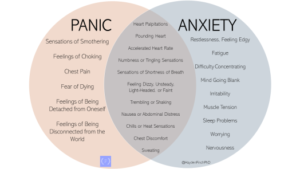Ways To Deal With Anxiety And Anxiety Attacks
Anxiety is a normal and often healthy emotion. However, when a person regularly feels disproportionate levels of anxiety, it might become a medical disorder.
The American Psychological Association (APA) defines anxiety as “an emotion characterized by feelings of tension, worried thoughts and physical changes like increased blood pressure.”
Since the earliest days of humanity, the approach of predators and incoming danger sets off alarms in the body and allows evasive action. These alarms become noticeable in the form of a raised heartbeat, sweating, and increased sensitivity to surroundings.
The danger causes a rush of adrenalin, a hormone and chemical messenger in the brain, which in turn triggers these anxious reactions in a process called the “fight-or-flight’ response. This prepares humans to physically confront or flee any potential threats to safety.
The duration or severity of an anxious feeling can sometimes be out of proportion to the original trigger, or stressor. Physical symptoms, such as increased blood pressure and nausea, may also develop. These responses move beyond anxiety into an anxiety disorder.
The APA describes a person with anxiety disorder as “having recurring intrusive thoughts or concerns.” Once anxiety reaches the stage of a disorder, it can interfere with daily function.
If your anxiety is focused around a situation, such as being worried about an upcoming event, you may notice the symptoms are short-lived and usually subside after the anticipated event takes place.
SYMPTOMS

Image source – Medical News Today
The symptoms of generalized anxiety disorder (GAD) will often include the following:
- Restlessness, and a feeling of being “on-edge”
- Uncontrollable and excessive feelings of worry
- Increased irritability
- Being easily tired.
- Concentration difficulties or having your mind go blank.
- Having tense or sore muscles.
- Over-planning
- Headache
- Sweating
- Dry mouth
- Seeking reassurance from others
- Sleep difficulties
Self-treatment

Image source – Psych Central Blogs
In some cases, a person can treat an anxiety disorder at home without clinical supervision. However, this may not be effective for severe or long-term anxiety disorders.
There are several exercises and actions to help a person cope with milder, more focused, or shorter-term anxiety disorders.
Question your fears
Negative thoughts tend to take over your mind. They take root in your mind and distort the severity of the situation. You must know how to challenge your fears. You have to start noticing at what point you can take control over them.
Take deep breath
Take 5-minutes break. You should take your thoughts under control in these 5 minutes. Sit down at a place comfortably where you have enough amount of air. Start taking deep breaths. Take 4 deep breaths. Inhale 4 times and exhale 4 times. This will help you calm down and relax your mind.
Go for a walk
It is better if you have a place nearby to go for a stroll. Walk slowly and concentrate on you breathing while you do so. Take a 15-minute walk and then sit and relax your body.
Write your thoughts
Writing is always a good idea. It helps one to put each and every thought on a paper without holding it back. You can keep a diary/journal to help you get back at it whenever you want. In case you don’t have your journal while you feel anxious, take a paper or notepad and start scribbling your thoughts.
Routine meditation
Meditation takes a long time to master. But you have to start it slow. Take about 5 minutes in the beginning and sit at a comfortable place. Take the position of meditation and close your eyes. Don’t try to focus on glabella (between your eyebrows). That is the way for higher levels. Right now, just focus on the present – in the moment. Push your thoughts whenever they occur – and they will occur and reoccur A LOT!
When done regularly, it can eventually help you train your brain to dismiss anxious thoughts when they arise.
Keeping mind and body healthy
Exercising regularly, eating balanced meals, getting enough sleep, and staying connected to people who care about you are great ways to stave off anxiety symptoms.
Some people tend to calm down with certain fragrances. Whether they’re in oil form, incense, candle or scents like lavender and sandalwood can be very soothing. This is known as Aromatherapy and is thought to help activate certain receptors in your brain, potentially easing anxiety.
Clinical help
If your anxiety is severe enough then your mental health practitioner will provide you with medications according to your symptoms. Discuss your concerns with your doctor.
Anxiety attacks

Image source – Hayden Finch, PhD
Every person deals with anxiety at one time or another. It is a part of our brain’s response to a perceived danger even if that danger isn’t real.
That said, there are times anxiety can get serious and turn into anxiety attacks that initially feel manageable and then gradually build up over a few hours. (This is different from a panic attack, which is out of the blue and subsides)
Signs of an anxiety attack
These are some of the more common mental and physical symptoms of anxiety:
- Feelings of danger, panic, or dread
- Rapid heart rate
- Nervousness or restlessness
- Sweating
- Hyperventilation
- Trembling/chills
- Tiredness or weakness
- Gastrointestinal problems
- Difficulty in focusing
It is very much possible to experience an anxiety and panic attack simultaneously.
Some mindful strategies to cope with these attacks are – focusing on an object, repeating a mantra, closing your eyes, and going to your happy place.
Anxiety itself is not a medical condition but a natural emotion that is vital for survival when an individual finds themselves facing danger.
An anxiety disorder develops when this reaction becomes exaggerated or out-of-proportion to the trigger that causes it. There are several types of anxiety disorder, including panic disorder, phobias, and social anxiety.
Treatment involves a combination of different types of therapy, medication, and counseling, alongside self-help measures.
An active lifestyle with a balanced diet can help keep anxious emotions within healthy limits.













